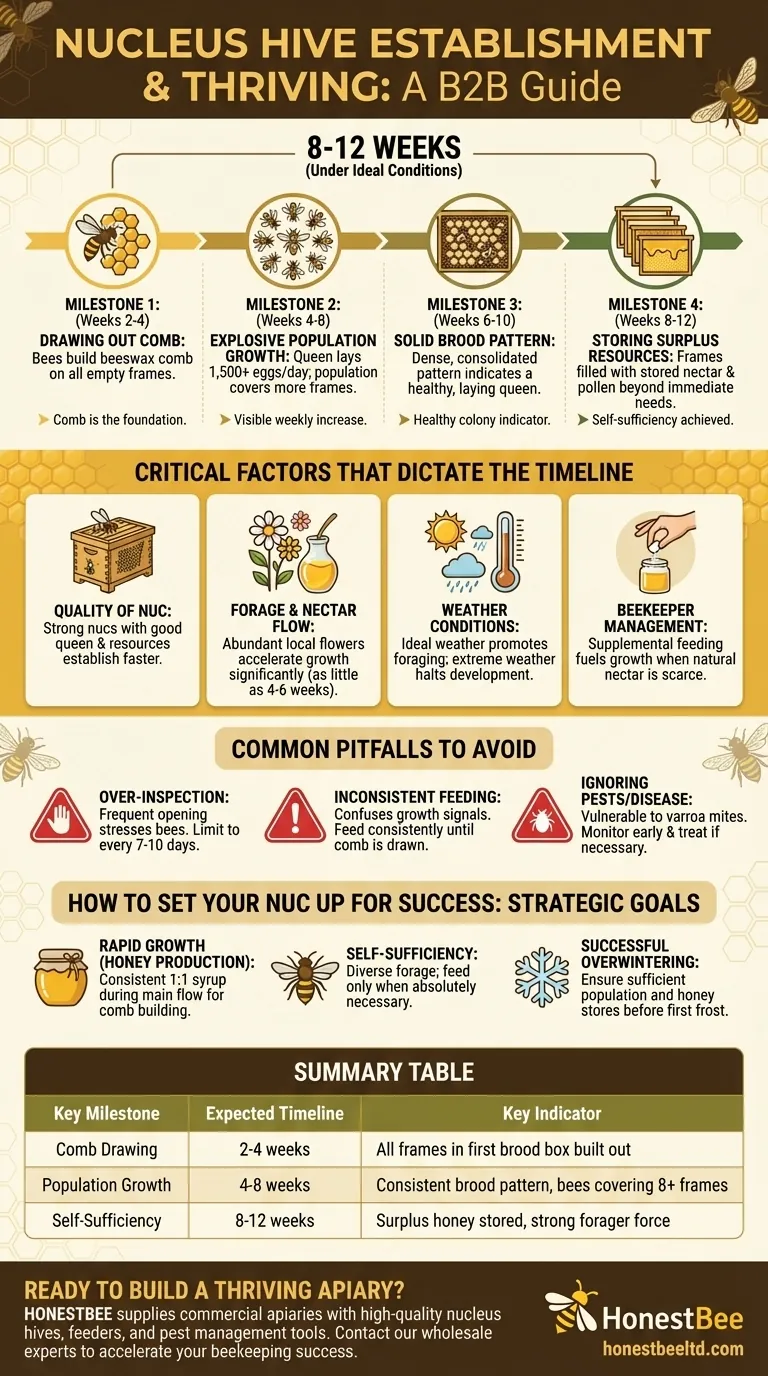Under ideal conditions, a nucleus hive typically takes 8 to 12 weeks to become a fully established, thriving colony. This timeline involves the bees drawing out all the frames in their first hive body, significantly increasing their population, establishing a consistent brood pattern, and beginning to store surplus honey.
The success and speed of a nucleus hive's development depend less on a fixed calendar and more on three critical factors: the initial quality of the nuc, the availability of food resources, and the beekeeper's management practices.

What "Established" Really Means
A nucleus hive, or "nuc," is a small, starter colony. The goal is to grow it into a full-sized, self-sufficient hive. Success is measured by observing a few key developmental milestones.
### Drawing Out Comb
The bees must build out beeswax comb on all the empty frames in their new hive box. This is their first and most energy-intensive task, as comb is the foundation for raising brood and storing food.
### Explosive Population Growth
A healthy queen can lay over 1,500 eggs per day. As new bees emerge, the colony's population should visibly increase week over week, covering more and more frames.
### A Solid Brood Pattern
When you inspect the central frames, you should see a dense, consolidated pattern of eggs, larvae, and capped brood. This indicates the queen is healthy and laying well.
### Storing Surplus Resources
An established hive doesn't just live day-to-day. You will see frames being filled with stored nectar (honey) and pollen beyond what the colony needs for its immediate survival.
Key Factors That Dictate the Timeline
While 8-12 weeks is a good benchmark, several variables can dramatically speed up or slow down the process. Understanding these factors is the key to effective beekeeping.
### The Quality of Your Nuc
Not all nucs are created equal. A strong nuc with five well-covered frames, a young, mated queen, and existing brood will establish much faster than a smaller nuc with fewer resources.
### Forage and Nectar Flow
The single biggest accelerator is the availability of food. A nuc installed at the beginning of a strong nectar flow (when local flowers are blooming profusely) can establish itself in as little as 4-6 weeks.
### Weather Conditions
Bees are highly dependent on weather. Long periods of rain, cold, or extreme heat will keep them inside, halting foraging and slowing development significantly.
### Beekeeper Management
Your actions matter. Providing supplemental sugar syrup can fuel comb construction and growth when natural nectar is scarce, effectively helping the colony bridge gaps in forage.
Common Pitfalls to Avoid
Your role as the beekeeper is to support the colony's natural instincts, not hinder them. Avoiding common mistakes is just as important as active management.
### The Danger of Over-Inspection
New beekeepers are often enthusiastic, but opening the hive too frequently can be detrimental. Each inspection breaks the hive's climate seal (propolis) and stresses the bees, setting them back by a day or more. Limit inspections to once every 7-10 days.
### The Risk of Inconsistent Feeding
If you choose to feed your new colony, consistency is critical. Starting and stopping feeding can confuse the colony's growth signals. Feed consistently until they have drawn out all the comb in their first brood box.
### Ignoring Pest and Disease Pressure
A small nuc is vulnerable to pests like varroa mites. A high mite load can quickly overwhelm a developing colony, leading to its collapse. Monitor for pests early and be prepared to treat if necessary.
How to Set Your Nuc Up for Success
Your management strategy should align with your specific goals for the hive.
- If your primary focus is rapid growth for honey production: Provide consistent 1:1 sugar syrup to fuel comb building and population expansion during the main nectar flow.
- If your primary focus is creating a resilient, self-sufficient colony: Place the hive in an area with diverse and abundant natural forage and intervene with feeding only when absolutely necessary.
- If your primary focus is successfully overwintering: Ensure the colony has enough time to build its population and store sufficient honey before the first frost, which may require feeding in late summer.
By understanding these core principles, you can actively guide your new colony from a small nucleus into a powerful and productive hive.
Summary Table:
| Key Milestone | Expected Timeline | Key Indicator |
|---|---|---|
| Comb Drawing | 2-4 weeks | All frames in first brood box built out |
| Population Growth | 4-8 weeks | Consistent brood pattern, bees covering 8+ frames |
| Self-Sufficiency | 8-12 weeks | Surplus honey stored, strong forager force |
Ready to build a thriving apiary? HONESTBEE supplies commercial apiaries and beekeeping equipment distributors with the high-quality nucleus hives, feeders, and pest management tools needed for rapid, successful colony establishment. Contact our wholesale experts today to discuss bulk pricing and how our supplies can accelerate your beekeeping success.
Visual Guide

Related Products
- 5 Frame Wooden Nuc Box for Beekeeping
- HONESTBEE Advanced Ergonomic Stainless Steel Hive Tool for Beekeeping
- Multi-Function Plier-Style Frame Grip Hive Tool
- HONESTBEE Professional Long Handled Hive Tool with Precision Cutting Blade
- HONESTBEE Professional Multi-Functional Hive Tool with Ergonomic Wood Handle
People Also Ask
- What is the purpose of having a nuc in beekeeping? Build a Resilient & Productive Apiary
- What are the benefits of moving nuclei around the apiary? Master Strategic Hive Management
- What are the benefits of starting a new bee colony in a nuc box? Boost Colony Success with Efficient Beekeeping
- What is a common feature of many 5-frame nuc boxes? The Integrated Feeder for Efficient Colony Growth
- What is the most common type of standard nuc? The 5-Frame Nuc Explained



















